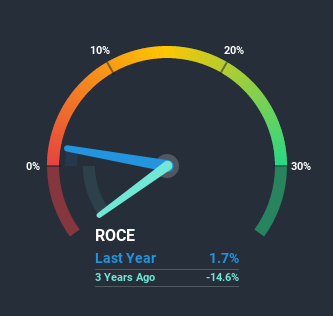Does Chegg (NYSE:CHGG) Have The Makings Of A Multi-Bagger?

Want to participate in a short research study? Help shape the future of investing tools and earn a $40 gift card!
If you're looking for a multi-bagger, there's a few things to keep an eye out for. In a perfect world, we'd like to see a company investing more capital into its business and ideally the returns earned from that capital are also increasing. Put simply, these types of businesses are compounding machines, meaning they are continually reinvesting their earnings at ever-higher rates of return. So when we looked at Chegg (NYSE:CHGG) and its trend of ROCE, we really liked what we saw.
What is Return On Capital Employed (ROCE)?
If you haven't worked with ROCE before, it measures the 'return' (pre-tax profit) a company generates from capital employed in its business. To calculate this metric for Chegg, this is the formula:
Return on Capital Employed = Earnings Before Interest and Tax (EBIT) ÷ (Total Assets - Current Liabilities)
0.017 = US$23m ÷ (US$1.5b - US$102m) (Based on the trailing twelve months to March 2020).
Therefore, Chegg has an ROCE of 1.7%. In absolute terms, that's a low return and it also under-performs the Consumer Services industry average of 7.7%.
Check out our latest analysis for Chegg
In the above chart we have a measured Chegg's prior ROCE against its prior performance, but the future is arguably more important. If you're interested, you can view the analysts predictions in our free report on analyst forecasts for the company.
How Are Returns Trending?
The fact that Chegg is now generating some pre-tax profits from its prior investments is very encouraging. The company was generating losses five years ago, but now it's earning 1.7% which is a sight for sore eyes. And unsurprisingly, like most companies trying to break into the black, Chegg is utilizing 481% more capital than it was five years ago. This can tell us that the company has plenty of reinvestment opportunities that are able to generate higher returns.
On a related note, the company's ratio of current liabilities to total assets has decreased to 6.8%, which basically reduces it's funding from the likes of short-term creditors or suppliers. So shareholders would be pleased that the growth in returns has mostly come from underlying business performance.
The Bottom Line On Chegg's ROCE
Overall, Chegg gets a big tick from us thanks in most part to the fact that it is now profitable and is reinvesting in its business. Since the stock has returned a staggering 807% to shareholders over the last five years, it looks like investors are recognizing these changes. With that being said, we still think the promising fundamentals mean the company deserves some further due diligence.
On a separate note, we've found 2 warning signs for Chegg you'll probably want to know about.
While Chegg isn't earning the highest return, check out this free list of companies that are earning high returns on equity with solid balance sheets.
This article by Simply Wall St is general in nature. It does not constitute a recommendation to buy or sell any stock, and does not take account of your objectives, or your financial situation. We aim to bring you long-term focused analysis driven by fundamental data. Note that our analysis may not factor in the latest price-sensitive company announcements or qualitative material. Simply Wall St has no position in any stocks mentioned.
Have feedback on this article? Concerned about the content? Get in touch with us directly. Alternatively, email editorial-team@simplywallst.com.

